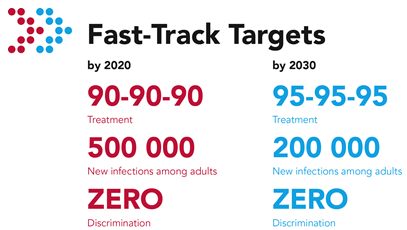
22 Nov The Netherlands on course to reaching UNAIDS 2020 fast-track targets
The latest figures released today by Stichting HIV Monitoring (SHM) for 2017 reveal a reduction in both HIV diagnoses and the estimated number of newly-acquired HIV infections in the Netherlands.
In 2017, fewer people were diagnosed with HIV (750) than in 2016 (820). The figures, published online today in the annual HIV Monitoring Report, also reveal that the majority of people are now starting HIV treatment within a few months of diagnosis. However, too many people continue to be diagnosed with an already impaired immune system or AIDS (37% of men who have sex with men, 63% of other men and 52% of women diagnosed in 2017).
On a positive note, the Netherlands has now reached the global UNAIDS’ ‘90-90-90’ fast-track target for 2020: in 2017, 90% of people estimated to be living with HIV in the Netherlands were aware of their HIV-positive status, 93% of these people were on treatment, and 95% of those on treatment had undetectable levels of the virus in their blood.
Another measure of the HIV epidemic, the estimated number of newly-acquired HIV infections, is also declining and reached 450 in 2017. This downward trend in newly-acquired infections over the years confirms that the Netherlands is also on course to achieving another UNAIDS’ fast-track target for 2020, namely that of a 75% reduction in annual newly-acquired infections since 2010.
Professor Peter Reiss, director of Stichting HIV Monitoring and AIGHD academic staff, says “It is encouraging that the annual number of newly-acquired infections continues to decline. Achieving all three goals of the UNAIDS’ 90-90-90 target has certainly contributed to preventing further HIV transmission. At the same time, we need to fully optimise prevention, including the implementation of PrEP, to minimise transmission. Moreover, we must increasingly shift our focus to addressing any persistent structural barriers to early diagnosis and timely treatment”.
The full HIV Monitoring Report 2018 and accompanying summary (in both Dutch and English) is available on SHM’s website.
Additional key findings included in the report
- In 2017, 23,100 people were estimated to be living with HIV in the Netherlands; around 2,300 (10%) of these people were unaware of their HIV infection and 20,844 (90%) people had been diagnosed with HIV and had at some point attended an HIV treatment centre. By the end of 2017, 19,675 people were still in HIV care. Of the 20,844 people who have ever been in care, 19,289 (93%) had started combination antiretroviral therapy (cART) and in 18,270 of those people (95%) the virus could no longer be detected in their blood.
- Of the people in whom HIV was diagnosed in 2017, two-thirds were men who have sex with men. The remaining people were mainly men and women who had acquired HIV through heterosexual contact.
- Approximately 40% of all new diagnoses in 2017 involved people who had been born outside the Netherlands.
- A quarter of all newly-diagnosed people in 2017 were aged 50 years or older at the time of diagnosis.
- Of those people who entered HIV care in 2017, almost everyone had started treatment (cART) within 6 months, and of those who were diagnosed in 2017, approximately two-thirds had started treatment within one month of diagnosis.
- 95% of those people living with HIV who started treatment in the last 5 years had no detectable HIV in their blood within 6 months.
- Increasingly fewer people are dying of AIDS in the Netherlands. AIDS-related death mainly occurs because people enter care too late, are unaware that they have acquired HIV, and already have a weakened immune system.
- Of the people who were in care at an HIV treatment centre in 2017, almost half (48%) were above 50 years of age and nearly a fifth (18%) were above 60. Many of these people suffer increasingly from other conditions that are related to ageing. Together with this increase in ageing-related conditions, the cause of death among HIV-positive individuals is now shifting towards cardiovascular disease, non HIV/AIDS-related forms of cancer and chronic liver disease
- More people who, in addition to HIV, also have a hepatitis C virus (HCV) infection have been treated with the available combinations of direct-acting antivirals (DAAs) against HCV. Of those that have completed the treatment and have been followed sufficiently long to measure the effect of the treatment, 97% were cured of their HCV infection.
[Content from press release by Stichting HIV Monitoring]
Image credit: UNAIDS
